In the realm of modern education, Software-as-a-Service (SaaS) solutions have emerged as transformative tools, reshaping the conventional learning landscape. These innovative SaaS platforms are revolutionizing educational methodologies, offering new prospects for students, educators, and institutions.
This article navigates through the profound impact of SaaS in education, delineating its role in fostering personalized learning and collaborative environments, redefining traditional classrooms, and streamlining administrative processes.
Transformative Potential of SaaS in Education
The integration of SaaS solutions in education heralds an era of personalized learning experiences. Leveraging data analytics and artificial intelligence, these platforms tailor educational content to suit individual learning styles and needs.
This adaptive learning approach empowers students to progress at their own pace, emphasizing personalized content that resonates with their unique abilities.
Explore Azure’s Log Analysis in this post Application Insights Logging: Azure’s Log Capabilities
Collaborative Learning
Educational SaaS tools facilitate seamless collaboration among students, educators, and parents irrespective of geographical barriers. These cloud-based platforms foster real-time collaboration, enabling group projects, resource sharing, and interactive discussions.
By providing a conducive environment for communication and teamwork, these tools nurture essential skills vital for success in today’s interconnected world.
Virtual Classrooms
The advent of educational SaaS industries has given rise to virtual classrooms, eradicating geographical limitations. These platforms offer diverse tools for live lectures, interactive discussions, and digital whiteboards, replicating traditional classroom experiences in a digital space.
The flexibility of virtual classrooms allows students worldwide to access quality education, transcending geographical boundaries.
Efficiency Enhancement with SaaS
Educational SaaS solutions streamline administrative tasks, simplifying student information management, attendance tracking, grade management, and scheduling into a centralized system.
Automating these processes liberates valuable time and resources for institutions to prioritize teaching and learning, optimizing the overall educational experience.
Revolutionizing the assessment process, SaaS tools offer diverse question types, automated grading, and prompt feedback mechanisms. Educators utilize these platforms to track student progress, identify areas for improvement, and provide personalized interventions based on data-driven insights.
This data-centric approach fosters continuous improvement and tailored instruction.
Beyond traditional education, educational SaaS platforms cater to lifelong learners and professionals, offering online courses, certifications, and professional development programs.
These flexible, self-paced learning opportunities enable continuous skill enhancement and knowledge acquisition, empowering individuals to stay updated with industry trends and advance their careers.
Further Explorations in SaaS for Education
In the realm of educational SaaS, ensuring robust data security and privacy measures is paramount. These platforms handle sensitive student information and require stringent protocols to safeguard against unauthorized access or data breaches.
Implementing encryption, secure authentication mechanisms, and compliance with data protection regulations are crucial aspects of maintaining data integrity and protecting student confidentiality.
The integration of adaptive learning technologies within educational SaaS solutions enhances personalized learning experiences. By continuously analyzing student performance and behavior, these technologies dynamically adjust learning paths, recommending tailored content and activities to address individual learning gaps and strengths. This adaptive approach optimizes learning outcomes and fosters a more engaging and effective learning journey.
Artificial Intelligence (AI) plays a pivotal role in educational SaaS by introducing intelligent assistants that aid both educators and students. AI-powered assistants can automate administrative tasks, offer personalized tutoring, provide instant feedback on assignments, and even adapt teaching methods based on individual student progress.
These assistants augment the teaching process, offering additional support and guidance, particularly in personalized learning environments.
The incorporation of augmented reality (AR) and virtual reality (VR) technologies into educational SaaS platforms introduces immersive learning experiences. These technologies enable students to explore complex concepts through interactive simulations, virtual field trips, and 3D visualizations, fostering deeper understanding and retention of subject matter.
AR and VR applications in education revolutionize traditional teaching methods, making learning more engaging and captivating.
Conclusion
Educational SaaS solutions continue to redefine the educational landscape by fostering personalized and collaborative learning experiences while enhancing administrative efficiency.
The integration of advanced technologies like AI, AR, and VR further amplifies the transformative potential of these platforms, offering innovative ways to engage learners and improve educational outcomes.
As the educational landscape continues to evolve, SaaS solutions will remain pivotal in driving educational innovation, empowering learners, and facilitating a more inclusive and adaptive approach to education.
